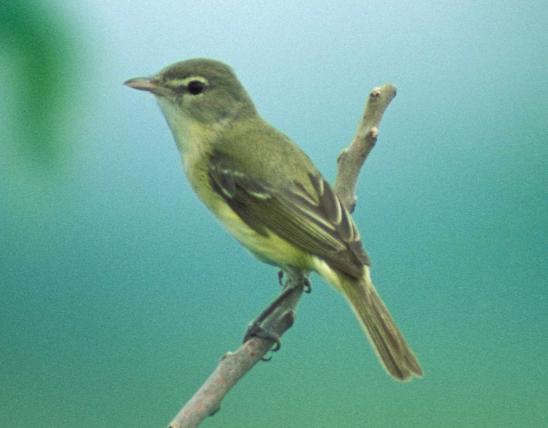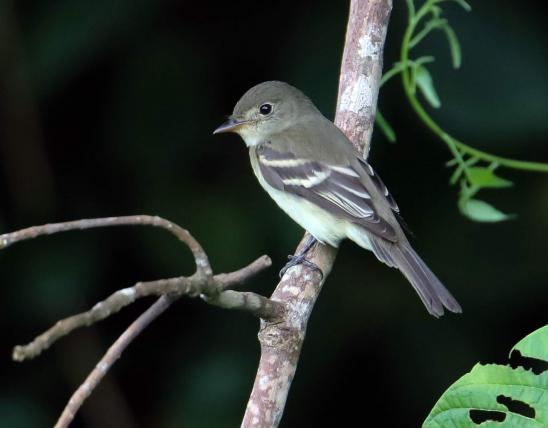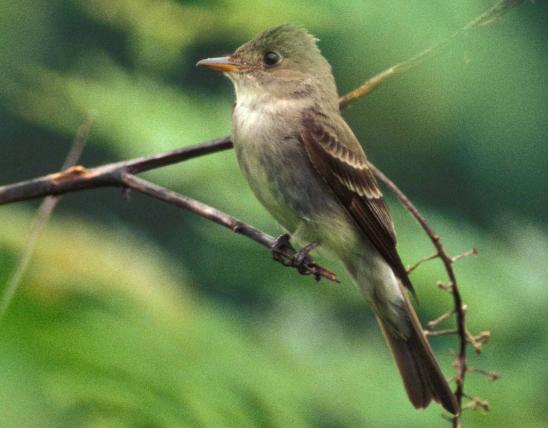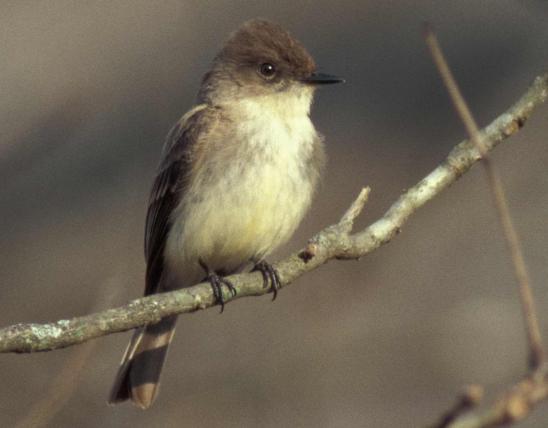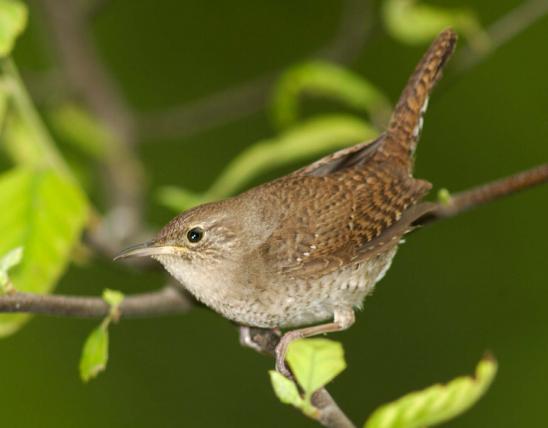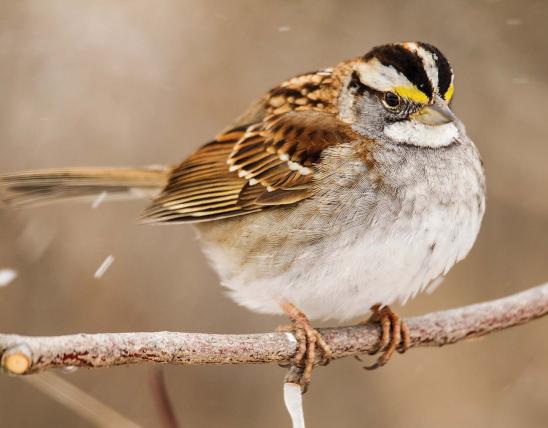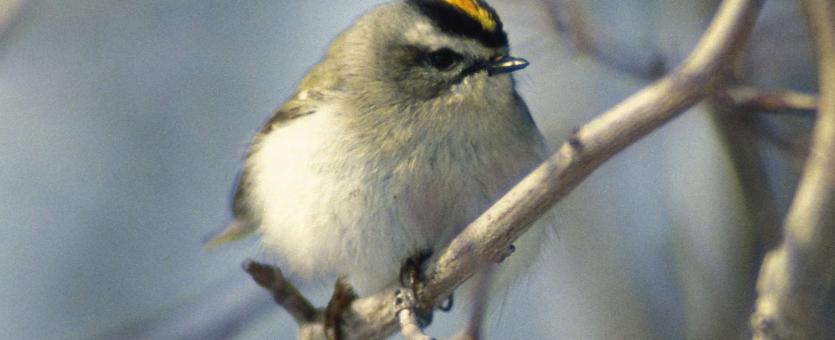
Kinglets are very small, active, insect-eating birds that nervously flit around. Golden-crowned kinglets are grayish olive, with black and white striping on the sides of the head. The black cap has a yellow center. Males have a bright orange center to the yellow crown stripe.
Adult upperparts are grayish olive, with a black cap with a yellow center. Note the white eyebrow, black eye line, thin black moustachial streak, and 2 white wing bars. The underparts are pale olive. The male has a bright orange center to the yellow crown stripe, which he raises when agitated. The song is a very high, two- or three-note, ascending, accelerating “see-see-sees” that often end with a jumble of lower-pitched warbling and chirping notes. The “see-see” notes are similar to the song of the brown creeper. It is so high and thin it can be hard for some people to hear.
Similar species:
- The only other North American kinglet is the ruby-crowned kinglet. The ruby-crowned kinglet is larger than the golden-crowned kinglet, has a red (not orange or yellow) crown, lacks the black and white striping on the side of the head, and has a different voice, with the “see-see-see” notes (not necessarily ascending) followed by three descending “hew-hew-hews,” jumbled warbles, and a loud series of repeated bubbly chirping phrases.
- To distinguish kinglets from wrens and other small birds with bills like tweezers, note the kinglets’ very small size, tiny bill, short, thin tail, the males’ colorful crown stripe (which can be erected into a small crest during courtship or territorial displays), and comparative proportions of wing and tail lengths. Kinglets seemingly have no necks. Kinglets are also fast-moving, high-energy birds and seem nervous or even frenzied. They typically flick their wings as they flit around.
Length: 4 inches (tip of bill to tip of tail) (slightly larger than a hummingbird).
Statewide during migration; in winter, more likely to be seen in the southern half of the state.
Habitat and Conservation
Look for golden-crowned kinglets in spring and fall in deciduous and evergreen woodlands and forests. Kinglets seem nervous as they constantly flit around. These very small birds are frequently seen in small flocks, often in association with chickadees, titmice, woodpeckers, and nuthatches.
In fall, migrating kinglets are easily approached as they forage in the dry leaves remaining on a tree, under loose bark, or in the needles of a coniferous tree such as eastern red cedar, shortleaf pine, or Norway spruce. You may be fortunate enough to see one in a tree in your backyard. However, if you want to search for one, you should visit a woodland area in a park, in the country, or in a nearby woods.
To see fall-migrating kinglets in the woods, listen patiently for the sounds of birds, and a mixed foraging flock may appear. These groups of active little birds — which may including titmice, woodpeckers, chickadees, and nuthatches — often include a few kinglets. Because of their tiny size, it may take a few minutes to find them. If you can determine the direction the flock is traveling, you might be able to stay with the flock until you have seen all the species present.
By wintertime, kinglets are less common in northern Missouri foraging flocks.
In spring, northbound golden-crowned kinglets appear about a week before ruby-crowned kinglets. Spring migrant populations are highest in May to early April.
Food
Forages among trees for insects, spiders, seeds, and fruits. Golden-crowned kinglets glean their prey from the bark of tree branches, from dry leaves on trees, and on the ground and in the new growth of the year.
See Habitat and Conservation and Ecosystem Connections for more about kinglets in mixed-species foraging flocks in fall and early winter. These flocks are organized so that the different species forage in slightly different locations (such as tree trunks, outer branches, lower branches, leaf litter, or among curled leaves) for slightly different foods.
Status
Common transient; as winter resident, uncommon in the south, rare in the north.
Life Cycle
Present in Missouri from late September to the end of April; populations are highest in late October to early November, and in May to early April.
Both species of kinglets arrive in mid- to late September from their breeding range in the coniferous forests of the northern United States and Canada. In early fall, they join the mixed-species foraging flocks that roam Missouri’s deciduous forests in search of insects, larvae, and eggs. By winter, kinglets are less common in the northern half of Missouri.
Kinglets migrate back north in late March and early April, starting with the golden-crowned kinglets. The ruby-crowned kinglets arrive a week or so later and are common when most warblers are passing through Missouri.
In their breeding range, golden-crowned kinglets construct four-cornered cup nests high in trees, building them out of a variety of fine materials such as plant down, bark strips, spider webs, feathers, fur, lichens, and mosses. There may be 1 or (more commonly) 2 broods a year. A clutch comprises 3–11 eggs, which are incubated for about 15 days. After hatching, the young remain in the nest for another 16–19 days before they start to fledge. Lifespan can exceed 6 years.
Human Connections
The golden-crowned kinglet is a birder’s bird: it’s tiny, lively, and its song can be hard to hear — so it helps to really know what to listen for. They’re small, drab, and hard to see, so you learn to look for their flitting movements. If you’re lucky, you might see the male raise his bright yolk-yellow crown. Birdwatching is a kind of sport that gets you outdoors at the crack of dawn and exhilarates you with the beauty and wonder of nature.
One of Missouri’s master birders was former state ornithologist Brad Jacobs, who gave us excellent advice for how to watch the mixed-species fall foraging flocks that kinglets often join:
“In order to observe forest birds in the nonbreeding season, one must have patience and a good ear. By walking quietly through the woods and listening carefully, you may hear a foraging flock or see some of the birds as they move into the area near you. Once you have located one or two birds, determine the direction in which they are moving and start traveling in the same direction. Even if you initially cannot see many of the other members of the foraging flock, you will likely find them in the next five to ten minutes. The key is simply to watch the behavior of these diminutive forest dwellers and follow them as they move about; if you keep looking, you will probably find the rest of the flock. If you decide to stop following the flock and go elsewhere, you may not see another flock for some time.”
Ecosystem Connections
The mixed-species foraging flocks that kinglets participate in are connected to habitat and other animals in many ways.
In Missouri and in other parts of the world, foraging flocks often organize themselves around a drab-colored species with a loud ringing voice. In Missouri this is usually the tufted titmouse.
Birds in mixed foraging flocks are usually insectivores, and usually they would compete with each other. But these flocks apparently help their participants in a variety of ways:
- It may increase the ability to find food when it is scarce. The more individuals searching for food, the less time any one individual spends searching the habitat already searched by other birds.
- A greater number of birds creates more pairs of eyes to look out for predators. And being an individual in a flock decreases a bird’s odds of being singled out and captured by a predator.
- Flocking may allow some birds to forage in areas where they would not be able to forage as an individual. For example, chickadees or titmice might be driven off the winter territory of a red-headed woodpecker if they are foraging alone. However, a mixed-species flock in the woodpecker’s territory causes a different reaction.
Missouri’s early-winter woodland foraging flocks are not unique. Similar mixed-species foraging flocks occur in grasslands, on mudflats, on water, or in shrub habitats, each with different suites of species. They occur in other parts of the world, too. In tropical America, for instance, foraging flocks often include both North American migrants and tropical resident species. In this case, the flocks usually include many more species and individuals than they do in our northern latitudes.
Although all the bird species in the foraging flock may be insectivores, they each exploit a different part of the food resources in the forest:
- Nuthatches, the upside-down birds, creep up and down tree trunks and on the tops and bottoms of branches.
- Kinglets search in rolled-up dried leaves still on trees or on the ground for insects and spiders.
- Chickadees search along branches, in leaves, or among next year's leaf buds.
- Downy woodpeckers forage along tree branches and tree trunks, probing cracks and looking under loose bark.
- Brown creepers spiral up the trunks of rough-barked trees, searching for insects in cracks and under bark — they may climb high in the tree before fluttering to the ground to begin searching the next tree from the bottom upward.

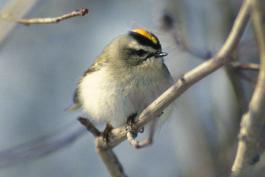
About 350 species of birds are likely to be seen in Missouri, though nearly 400 have been recorded within our borders. Most people know a bird when they see one — it has feathers, wings, and a bill. Birds are warm-blooded, and most species can fly. Many migrate hundreds or thousands of miles. Birds lay hard-shelled eggs (often in a nest), and the parents care for the young. Many communicate with songs and calls.
























